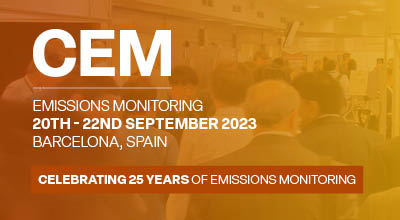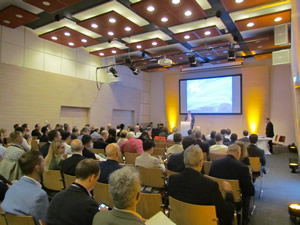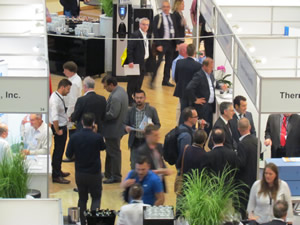

Following a hugely successful Conference and Exhibition in Budapest, the organisers of CEM 2018 have expressed their delight with the high volume of delegates, speakers and exhibitors that attended the event in May. In addition to the traditional themes of industrial emissions monitoring and regulation, the 2018 Conference also included other applications such as the monitoring of emissions from transport, including ships and motor vehicles. A variety of novel monitoring techniques were also described, such as the deployment of drones for the remote surveillance of large areas.
 “The lowering of emissions limits has placed a growing pressure on monitoring techniques and technologies, so CEM 2018 provided an excellent forum for all stakeholders to share ideas and experience,” commented Rod Robinson from NPL in the UK. “It was particularly interesting to hear from those responsible for monitoring transport emissions because they are addressing similar issues to those of us working with industrial emissions. Consequently, significant cross-pollination of ideas took place, because all sectors share the common goal of trustworthy, reliable data.
“The lowering of emissions limits has placed a growing pressure on monitoring techniques and technologies, so CEM 2018 provided an excellent forum for all stakeholders to share ideas and experience,” commented Rod Robinson from NPL in the UK. “It was particularly interesting to hear from those responsible for monitoring transport emissions because they are addressing similar issues to those of us working with industrial emissions. Consequently, significant cross-pollination of ideas took place, because all sectors share the common goal of trustworthy, reliable data.
“This was also the case for the speakers from India, who are faced with the fair and effective implementation of new emissions regulations across an enormous number of industrial plants.”
With 51 speakers from 11 countries, the Conference focused on the role of monitoring in air pollution and climate change; providing an insight into the latest regulations, technologies, Standards, methods and techniques. Visitors to CEM 2018 included anyone with a professional interest in emissions to air from industry, vehicles and ships. This included regulators, process operators, manufacturers, fleet operators, energy companies, engine manufacturers, waste management organisations, standards organisations, testing contractors, academia, researchers, instrument manufacturers, analytical companies, abatement companies and many more.
The first day of the CEM Conference focused on regulation, standardisation across Europe, limits of detection, measurement uncertainty and the applicability of standard reference methods. On the second day, delegates were presented with an opportunity to choose between two parallel sessions. The first addressed the monitoring and abatement of mercury and fine particulate emissions, followed by presentations on the monitoring of gaseous species at low concentrations.
Several of the speakers discussed the monitoring implications of existing and upcoming regulations that will reduce mercury emissions. Emilia Jyrkiäinen, for example, from Gasmet Technologies, said: “In the EU, new air pollution limits for large combustion plants will require utilities to invest in new pollution abatement technology. The requirements of the Industrial Emissions Directive (IED) (DIRECTIVE 2010/75/EU) for both abatement and monitoring are addressed in the Best Available Techniques Conclusions for Large Combustion Plants (LCP BREF). This requires large European power plants to comply with new emission limits values (ELVs) for mercury and other pollutants by 2021.” Speaking after the event Emelia added: “From my discussions with delegates, it was clear that many countries are already preparing for the new regulations and we believe that continuous monitoring will be preferred because this can also help improve process control.”
The alternative session focused on fugitive emissions and fence-line monitoring. The fugitive emissions presentations focused on methane and other hydrocarbons; a topic driven by the Paris Agreement (on climate change) and regulations (BAT Conclusions) for refineries. Later in the afternoon, the two groups reunited to hear four presentations on innovative measurement technologies.
On the third day, the Conference focused on innovative technologies and industrial case studies, providing real-world examples of how monitoring challenges have been overcome. The final presentation of the Conference was delivered to a packed audience by Ken Roberts of Gasmet UK. Ken provided a summary of three real-world case studies in which continuous monitoring systems were designed and installed to meet both regulatory requirements and site specific conditions. These included practical considerations such as the physical requirements for sampling points and the location of the CEMS. Ken says: “My two main objectives were to highlight the importance of involving the CEMS provider at an early stage, so that monitoring requirements can be incorporated in the plant design, and to ensure that the CEMS is future-proof; able to meet existing and forthcoming regulations.”
 The CEM 2018 Exhibition included many of the world’s leading providers of emissions measurement equipment and services. Gas and particulate sampling was a common feature on many of the booths, and several of the exhibition stands displayed mercury sampling and/or continuous monitoring equipment. Continuous Emissions Monitoring Systems (CEMS) featured widely, offering visitors the opportunity to find the solutions that best meet their needs. Experts from the exhibiting companies were available to provide advice in the implementation of CEMS according to EN-14181, including the three Quality Assurance Levels (QAL) and the Annual Surveillance Test (AST). The exhibition also featured portable and transportable emissions monitoring equipment as well as fugitive, indoor and ambient air quality monitors.
The CEM 2018 Exhibition included many of the world’s leading providers of emissions measurement equipment and services. Gas and particulate sampling was a common feature on many of the booths, and several of the exhibition stands displayed mercury sampling and/or continuous monitoring equipment. Continuous Emissions Monitoring Systems (CEMS) featured widely, offering visitors the opportunity to find the solutions that best meet their needs. Experts from the exhibiting companies were available to provide advice in the implementation of CEMS according to EN-14181, including the three Quality Assurance Levels (QAL) and the Annual Surveillance Test (AST). The exhibition also featured portable and transportable emissions monitoring equipment as well as fugitive, indoor and ambient air quality monitors.
Roberto Parola from Linde in Germany said: “CEM is becoming more and more an international event, providing an excellent opportunity to discuss technical topics with a broad audience and to build global business opportunities.” Thomas Eisenmann from Durag agreed, adding: “I strongly recommend the CEM event; it is one of very few events that I know focusing on all aspects of emissions monitoring. It brings together almost all significant technologies and players in the field, providing a good communication and networking opportunity.”
As a UK manufacturer of gas monitoring instrumentation, Signal Group participated in the CEM 2018 exhibition to find new clients, meet existing customers and discuss market trends with other exhibitors. Their Zahid Salim said: “We chose CEM 2018 to launch the new Series IV gas analysers. With 3G, 4G, GPRS, Bluetooth and satellite compatibility, each instrument is built with its own IP address and runs on Windows software, so users have simple and secure access to their analysers at any time, from anywhere. This proved to be of major interest to CEM visitors from all over the world, with the most popular products at this event being the fixed and portable FIDs.”
CEM 2018 visitors also reacted very positively to the event. For example, Sin Wai Oscar Lau, an Environmental Officer from CLP Power Hong Kong described it as “A wonderful event to understand the latest developments in emission monitoring,” and Michal Pawel, a laboratory manager for Centrum Badan Jakosci in Poland said: “CEM is an excellent platform for sharing experience in emission measurement.”
Summarising, CEM 2018 organiser Marcus Pattison says: "Air pollution and climate change have never before received such high levels of media and political attention. As such, there is an enormous focus on the quality and reliability of monitoring methods and standards, because reliable monitoring enables regulatory control, informs political decisions and enables the evaluation of mitigation and abatement measures. CEM 2018 therefore represented a great opportunity to hear about the latest developments, and to meet some of the world’s leading experts. The next CEM will take place in Krakow, Poland from 13th to 15th May 2020, and preparations are already underway!"